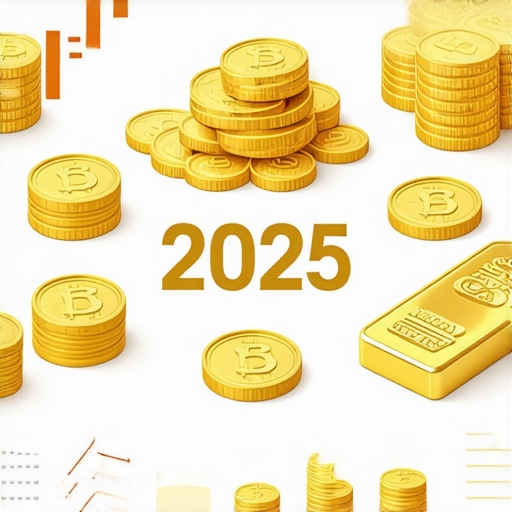Unveiling the Complexity of Gold Investment Vehicles in 2025: A Strategic Perspective
As global economic uncertainties persist, sophisticated investors recognize gold not merely as a safe haven but as a dynamic component of diversified portfolios. In 2025, understanding the nuanced distinctions among various gold investment types—namely coins, bars, and exchange-traded funds (ETFs)—becomes imperative for crafting resilient wealth preservation strategies. This exploration reveals the layered complexities and strategic implications of each gold vehicle, rooted in expert analysis and market trends.
Deciphering the Role of Physical Gold: Coins and Bars as Tangible Wealth Anchors
What are the core differences between gold coins and bars, and how do these distinctions influence investment decisions in 2025?
Physical gold investments, including coins and bars, serve as foundational assets for risk-averse investors seeking tangible security. Gold coins, often minted with numismatic or bullion significance, offer liquidity and potential collectible premiums. Conversely, gold bars—typically produced by refineries—favor large-scale accumulation and cost efficiency. The choice hinges on liquidity needs, storage logistics, and market premiums, with expert advice emphasizing secure acquisition from reputable dealers to mitigate counterparty risks (see here).
Gold ETFs: A Sophisticated Instrument for Market Exposure and Liquidity
How do gold ETFs compare with physical gold assets concerning liquidity, regulatory oversight, and price tracking in 2025?
Gold ETFs provide investors with market liquidity, ease of trading, and regulatory transparency, making them attractive for short-term tactical allocations. Unlike physical gold, ETFs negate storage and security concerns but introduce counterparty and management risks. Their prices closely track spot gold, influenced by factors such as global demand, currency fluctuations, and central bank policies. Recent market analyses suggest that in 2025, ETFs will continue to be a vital instrument for tactical gold exposure, especially amid volatile markets (see here).
Expert-Level Insights: Integrating Gold Vehicles for Optimal Portfolio Resilience
Smart investors in 2025 are integrating physical and paper gold, leveraging the stability of coins and bars with the liquidity of ETFs. This multi-layered approach mitigates risks associated with storage, market timing, and liquidity constraints. Moreover, understanding the influence of macroeconomic factors—such as global economic growth, inflation trajectories, and geopolitical tensions—is crucial for timing and allocation decisions (see here).
How can a seasoned investor develop a nuanced gold strategy that balances physical security and market liquidity in 2025?
Developing such a strategy involves assessing market conditions, risk appetite, and long-term wealth goals. Combining physical holdings for security and ETF exposure for liquidity and tactical flexibility—while continuously monitoring macroeconomic signals—ensures a resilient and adaptive portfolio. Consulting with financial advisors and leveraging technical analysis techniques, such as those outlined in this resource, helps refine timing and allocation.
For a deeper understanding of how global trends influence gold prices, and to stay ahead in the complex landscape of 2025 investments, explore our comprehensive content on price forecasts and market insights.
Engage with financial experts or contribute your insights on gold investment strategies to foster a community of informed wealth builders.
Leveraging Macro Trends: How Global Economics Shape Gold Investment Opportunities in 2025
Understanding the overarching macroeconomic landscape is fundamental for any seasoned gold investor in 2025. Factors such as inflation rates, currency fluctuations, and geopolitical tensions directly influence gold prices. For instance, rising inflation often prompts increased demand for gold as a hedge, while geopolitical uncertainties can trigger market volatility, creating tactical entry and exit points for traders. Experts suggest closely monitoring reports from institutions like the International Monetary Fund (IMF) and the World Bank, which provide vital insights into economic trajectories that impact gold valuations (see here).
Innovative Tools for Gold Portfolio Optimization: Harnessing Data and Technology
Advanced analytical tools, including machine learning algorithms and real-time market data feeds, empower investors to refine their gold trading strategies. Platforms offering predictive analytics can identify emerging trends before they become mainstream, giving traders a competitive edge. For example, integrating technical analysis with macroeconomic indicators can improve timing precision, as discussed in our resource on effective gold trading techniques. Staying ahead in 2025 requires embracing these technological innovations, which transform raw data into actionable insights.
What are the most effective ways for investors to integrate macroeconomic analysis with cutting-edge technology for optimal gold trading performance in 2025?
Combining macroeconomic insights with AI-driven analytics involves developing a multi-layered approach: first, regularly updating macroeconomic forecasts from trusted sources, then utilizing algorithmic trading platforms that incorporate these data points to generate buy or sell signals. Additionally, backtesting strategies using historical data helps refine models and reduce risk exposure. Experts emphasize continuous learning and adaptation, as outlined in our guide on developing long-term gold investment strategies. This integrated approach enhances decision-making precision amidst volatile markets.
Exploring Alternative Gold Investment Vehicles for Diversification in 2025
While physical gold and ETFs remain staples, alternative vehicles such as gold-focused mutual funds, mining stocks, and futures contracts offer diversified exposure. Gold mining stocks, for instance, provide leverage to gold prices and can outperform physical assets during bullish phases. Conversely, futures contracts allow for sophisticated tactical positioning but require deep market knowledge and risk management skills, as discussed in our analysis of futures market analysis techniques. Diversification across these instruments can buffer against specific risks and optimize overall portfolio performance in 2025.
How should investors balance exposure across physical gold, ETFs, and mining stocks to maximize growth while managing risk in 2025?
Achieving this balance involves aligning asset allocation with individual risk tolerance, investment horizon, and market outlook. Typically, a core holding of physical gold provides stability, complemented by ETFs for liquidity and tactical flexibility, and mining stocks for growth potential. Regular portfolio rebalancing, based on macroeconomic shifts and market signals, ensures resilience. For detailed guidance, consult our comprehensive content on building a long-term gold investment portfolio. Such strategic diversification is crucial for navigating the uncertainties of 2025 and beyond.
Engage with fellow investors or share your strategies in the comments to foster a community of informed wealth builders. For more insights, consider exploring our in-depth analysis on market forecasts and price predictions.
Harnessing the Synergy of Gold Investment Vehicles: A Deep Dive into Portfolio Optimization in 2025
In the rapidly evolving landscape of precious metals investment, the integration of physical gold, ETFs, mining stocks, and futures contracts offers a sophisticated toolkit for investors aiming to maximize returns while mitigating risks. This layered approach demands a nuanced understanding of each vehicle’s unique attributes and how they interact within a diversified portfolio. For example, combining stable physical holdings with the agility of futures contracts enables tactical positioning aligned with macroeconomic shifts, such as inflation surges or geopolitical upheavals (see here).
What advanced analytical models can investors deploy to optimize asset allocation across multiple gold investment vehicles in 2025?
Modern portfolio theory (MPT) remains foundational, but the advent of machine learning algorithms now allows for dynamic rebalancing based on real-time market data and predictive analytics. Techniques such as Monte Carlo simulations and Bayesian networks facilitate scenario analysis that incorporates macroeconomic variables, enabling investors to anticipate potential volatility and adjust allocations proactively. For instance, integrating sentiment analysis of geopolitical news feeds with quantitative models enhances predictive accuracy, positioning portfolios for resilience (see here).
Liquidating and Rebalancing: Navigating Market Volatility with Precision
Effective rebalancing strategies hinge on a comprehensive understanding of market signals and the timing of liquidations. Investors should leverage algorithmic trading platforms that incorporate macroeconomic indicators such as GDP growth rates, inflation expectations, and central bank policies. Additionally, employing options strategies like collars or spreads can hedge against adverse movements in gold prices, providing downside protection without sacrificing upside potential. This tactical flexibility is particularly vital in 2025, where market volatility driven by geopolitical tensions and monetary policy shifts can create both risks and opportunities (see here).
How can investors incorporate macroeconomic forecasts and technical analysis into automated trading systems for optimal rebalancing in 2025?
Developing an integrated approach involves synthesizing macroeconomic forecasts—such as inflation trajectories from IMF reports—with technical indicators like moving averages and Fibonacci retracements. Advanced trading algorithms can be programmed to respond to specific signals, such as a breakout above resistance levels combined with rising inflation expectations, triggering rebalancing trades. Continuous backtesting and machine learning model updates ensure these systems adapt to evolving market conditions, significantly enhancing decision-making precision (see here).
Emerging Alternative Gold Investment Vehicles: Opportunities and Risks in 2025
Beyond traditional assets, innovative vehicles such as gold royalty and streaming companies, blockchain-backed tokens, and environmentally focused mining funds are gaining traction. These options provide exposure to gold price movements with distinct risk-return profiles. For example, streaming companies offer leverage to gold prices with lower operational risks, but are sensitive to commodity price fluctuations and contractual complexities. Blockchain tokens promise liquidity and transparency but face regulatory uncertainties. Investors should conduct rigorous due diligence, considering factors like management quality, regulatory environment, and market liquidity to craft a balanced exposure (see here).
What criteria should sophisticated investors apply when evaluating emerging gold vehicles to ensure alignment with their strategic objectives in 2025?
Due diligence should encompass an assessment of the vehicle’s liquidity profile, management expertise, regulatory status, and historical performance. Moreover, analyzing correlation coefficients with traditional gold assets helps determine diversification benefits. Incorporating scenario analysis and stress testing under various geopolitical and macroeconomic scenarios ensures that these alternative investments complement core holdings and enhance overall portfolio resilience. Consulting industry reports and engaging with expert advisors are essential steps in this process (see here).
To deepen your understanding of how multi-asset strategies can be tailored for 2025, subscribe to our expert-led webinars and explore the extensive resources available on integrated gold investment planning. Engaging with a community of informed investors will further refine your strategic approach and foster continuous learning in this dynamic field.
The Convergence of Macro Trends and Sophisticated Gold Investment Approaches
In 2025, the landscape of gold investing is shaped by a confluence of macroeconomic forces and innovative financial instruments. Investors seeking to optimize their portfolios must delve into the intricacies of global economic indicators, geopolitical developments, and emerging asset classes. The integration of these elements enhances strategic agility and resilience, enabling investors to navigate volatility with precision.
Deciphering the Nuances of Gold Derivatives and Their Strategic Role
How can advanced derivatives such as options and swaps be leveraged for risk management and tactical positioning in gold markets?
Options and swaps serve as vital tools for sophisticated investors aiming to hedge against adverse price movements or to speculate on future trends. For instance, gold call options provide upside exposure while limiting downside risk, ideal for tactical entry points. Swaps can facilitate customized risk transfer agreements, aligning with macroeconomic expectations. According to research from the Journal of Derivatives & Hedge Funds, deploying these instruments with a clear understanding of implied volatility and Greeks metrics enhances portfolio resilience amidst market uncertainties (see here).
Harnessing Quantitative Models for Dynamic Asset Allocation in Gold Portfolios
Modern portfolio theory is augmented by machine learning algorithms that analyze vast datasets, including macroeconomic indicators, sentiment analysis, and technical signals. These models facilitate real-time rebalancing, optimizing asset allocation dynamically. Deep learning techniques, such as neural networks, can uncover nonlinear relationships and predict short-term price movements with greater accuracy, providing a competitive edge in volatile environments.
What are the best practices for integrating artificial intelligence into gold trading algorithms?
Effective AI integration involves continuous model training, validation, and adaptation to shifting market regimes. Combining macroeconomic forecasts from authoritative sources like the IMF with sentiment data from geopolitical news feeds enhances predictive accuracy. Investors should employ robust backtesting frameworks and scenario analysis to refine algorithms and mitigate overfitting, as outlined in the Financial Analysts Journal. This strategic sophistication ensures that trading systems remain resilient and adaptable in 2025’s complex market ecosystem.

Implementing these advanced tools requires a comprehensive understanding of both quantitative techniques and macroeconomic fundamentals. Engage with expert resources and consider consulting specialized quant analysts to develop tailored solutions that align with your investment objectives.
Evaluating Emerging Technologies: Blockchain-Backed Gold Assets and Environmental, Social, and Governance (ESG) Integration
What criteria should investors use to assess the viability and potential risks of blockchain-based gold tokens and ESG-compliant mining funds?
Assessment criteria include regulatory clarity, liquidity, transparency, and management expertise. Blockchain tokens must demonstrate security protocols, compliance with financial regulations, and a clear linkage to physical gold reserves. ESG funds require rigorous due diligence on environmental practices, social impact, and governance standards. Industry reports, such as those from the World Gold Council, provide comprehensive frameworks for evaluating these emerging assets (see here).
Developing a nuanced understanding of these criteria allows investors to incorporate innovative vehicles into diversified portfolios, balancing growth potential with risk mitigation. To deepen your expertise, participate in specialized webinars and engage with industry thought leaders, ensuring your investment strategy remains at the forefront of technological and environmental advancements.
Expert Insights & Advanced Considerations
1. Diversification Beyond Traditional Assets
In 2025, integrating emerging gold-related assets such as blockchain-backed tokens and ESG-compliant mining funds enhances portfolio resilience. These innovative vehicles offer diversification benefits and align with evolving regulatory and technological landscapes, demanding thorough due diligence and strategic allocation.
2. The Power of Quantitative and AI-Driven Models
Advanced analytical models, including machine learning algorithms and real-time data analytics, enable dynamic asset allocation and risk management. Utilizing these tools can uncover nonlinear market relationships, optimize rebalancing, and anticipate macroeconomic shifts impacting gold prices.
3. Macro Trends as Investment Catalysts
Global economic indicators—such as inflation rates, currency stability, and geopolitical developments—remain crucial for tactical decision-making. Expert monitoring of institutions like IMF and World Bank reports informs timing strategies and asset choices in the complex 2025 environment.
4. Alternative Investment Vehicles for Growth
Exploring mining stocks, futures contracts, and innovative assets like blockchain tokens provides tailored exposure to gold’s price movements. Balancing these with physical holdings can maximize growth potential while managing risks effectively.
5. Risk Mitigation via Derivatives and Hedging
Options and swaps serve as vital tools for hedging against adverse price movements. Strategic deployment of these derivatives enhances portfolio stability amid volatility driven by macroeconomic and geopolitical uncertainties.
Curated Expert Resources
- Gold Market Analysis 2024 & 2025: Offers comprehensive insights into market trends, supply-demand dynamics, and future price drivers, essential for informed decision-making.
- Developing Long-Term Gold Investment Strategies: Guides investors on structuring resilient portfolios considering macroeconomic forecasts and emerging asset classes.
- Effective Gold Trading Techniques: Provides tactical tools, technical analysis, and algorithmic strategies to optimize returns in volatile markets.
- Innovative Gold Investments 2025: Examines blockchain-backed tokens, ESG funds, and other alternative vehicles, highlighting criteria for evaluation and risk management.
- Macro Economic Outlook Reports: Critical for understanding inflation, currency trends, and geopolitical risks shaping gold investment opportunities.
Final Expert Perspective
In 2025, mastering the nuances of gold investment vehicles requires a blend of macroeconomic insight, technological sophistication, and strategic diversification. A comprehensive understanding of emerging assets and advanced analytical tools positions investors to navigate volatility with resilience and precision. Engaging with authoritative resources and continuous learning remains paramount for those aspiring to excel in this complex landscape. We invite you to share your insights, explore our in-depth guides, and stay at the forefront of gold investment strategies—your expertise will shape the future of wealth preservation in an uncertain world.










